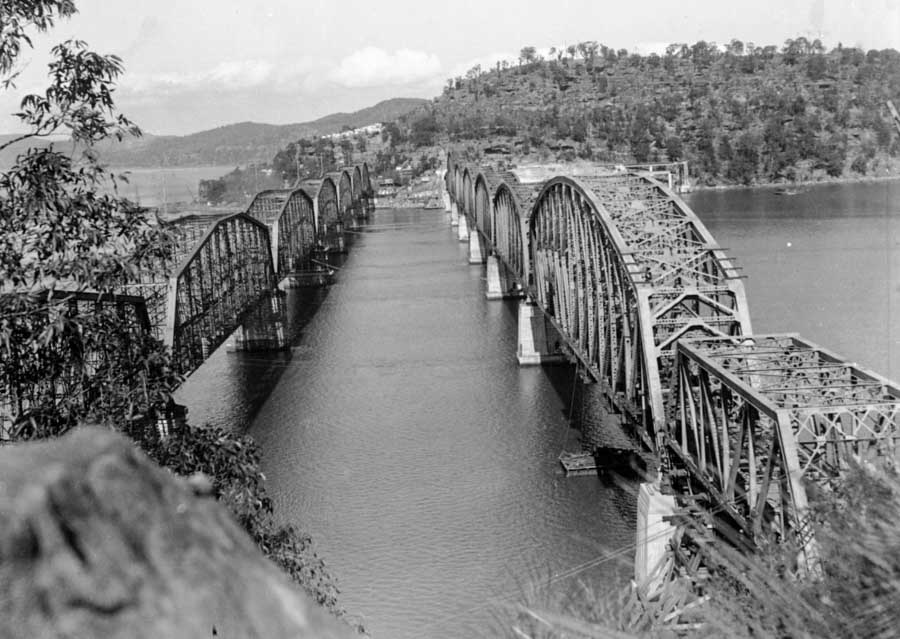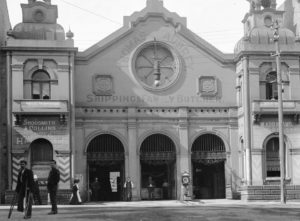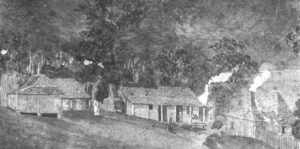By 1937 it had become apparent that the first bridge over the Hawkesbury River, NSW – a key link in the rail connection between the state capital Sydney and the north of the state – was badly in need of replacement.
Cracks had appeared in at least one of the piers supporting the bridge and emergency steelwork was clamped around pier number 4 to prevent it failing. Investigations of the other piers found the concrete wasn’t suitable for the loads the bridge was expected to support. Meanwhile, it was also found that the bearings supporting the bridge were seized and engineers felt the design of the tie members in the upper structure were no longer adequate and allowed too much vibration. All this meant that repair was out of the question.
.

Note the reinforcement of the old bridge pier in the background.
.
The problems with the bridge meant that one of its two rail lines had to be put out of commission to reduce loads, and trains had to slow to a crawl and avoid braking when crossing. This was a serious chokepoint in a vital strategic rail link.
Once it was decided a new bridge would be necessary, the site chosen was about 60m upstream of the old bridge. Test bores confirmed the suspicion of engineers that the river bed was covered with very deep layers of silt – peppered with large boulders – and that firm footings would be extremely hard to achieve.
Remarkably, the entire project was designed by staff at the Works and Way branch of NSW Railways, and all the steelwork was fabricated at the branch’s Chullora Per Way Shops. The new bridge featured much bigger bearings than those on the old bridge, completely redesigned trusses and ties and revamped connections between truss members, resulting in a structure much more capable of carrying the great weights of newer engines and rolling stock, travelling at higher speeds than in the past.
While the old bridge had seven spans of 127m, the new bridge has eight spans: two of 136m, four of 106m and two at 45m. The overall length of the bridge is 815m and the total weight of steel is 7860 tonnes.
Also unlike the first bridge, the second was built entirely from Australian-made steel.
.
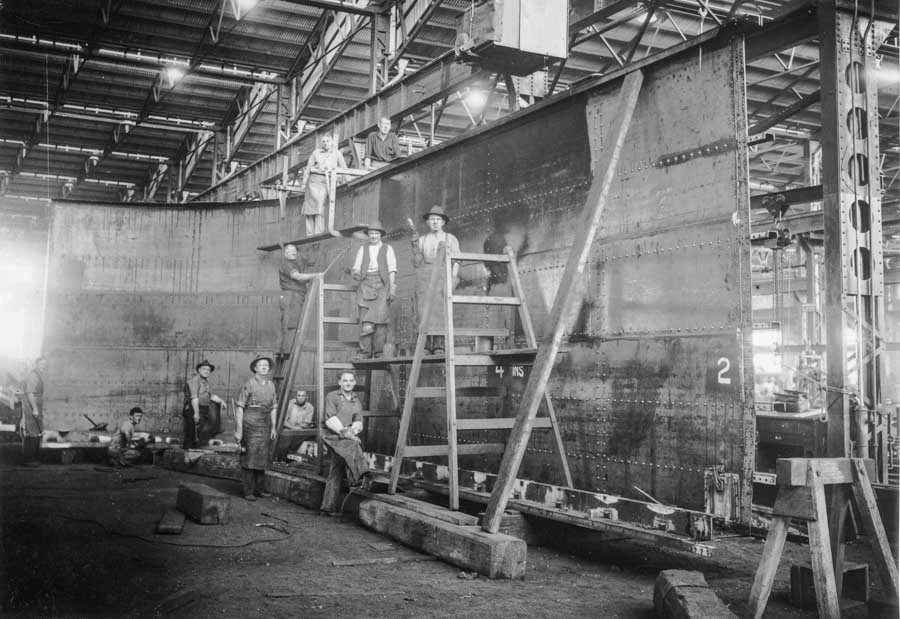
Work on one of the caissons. 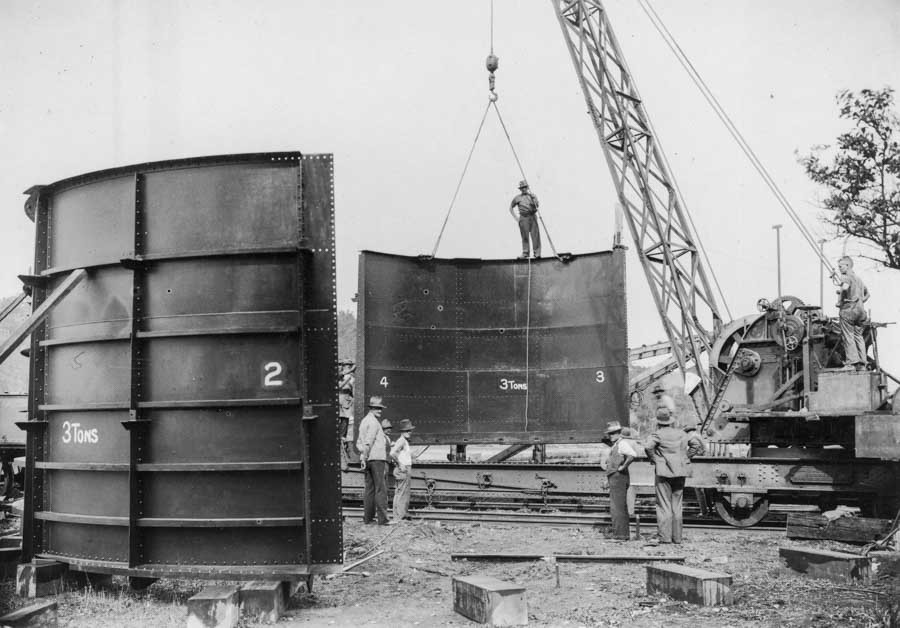
Work on one of the caissons.
Construction started in 1939, and the outbreak of World War 2 made the project more urgent but also reduced the resources available to the job. The peak workforce, in June 1941, was 493. It was believed that the bridge would be a prime target for the Japanese during the war, so guns were mounted at the entrance to Broken Bay and a minefield and submarine nets were set near the bridge.
Six men lost their lives during the construction of the bridge. They were Edward Anderson, Arthur E. Preston, Horace C. Ogden, Ernest Palmer. James Lundman and Clarrie Kemp. A plaque commemorating these men was affixed to the bridge and unveiled at the official opening on July 1, 1946.
.
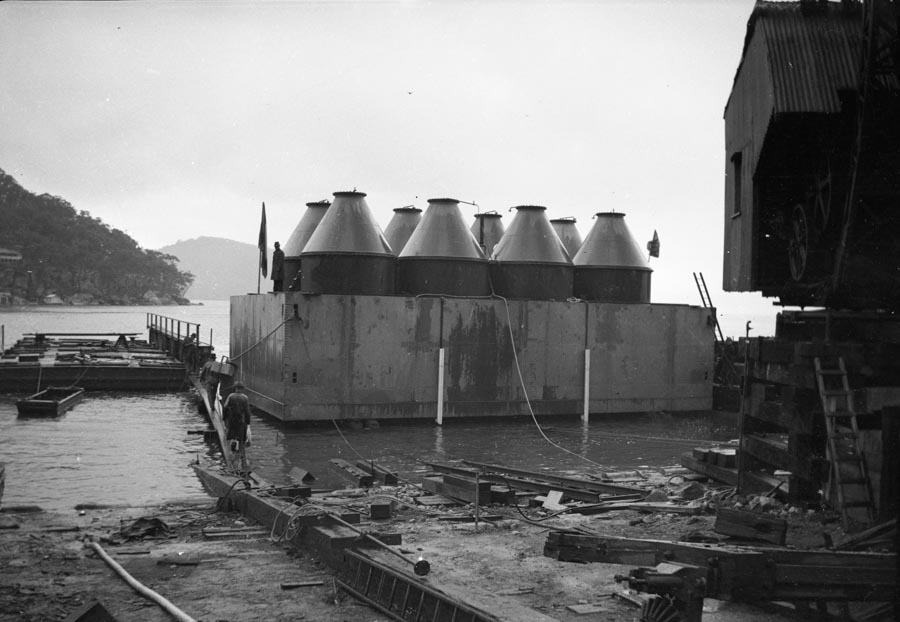
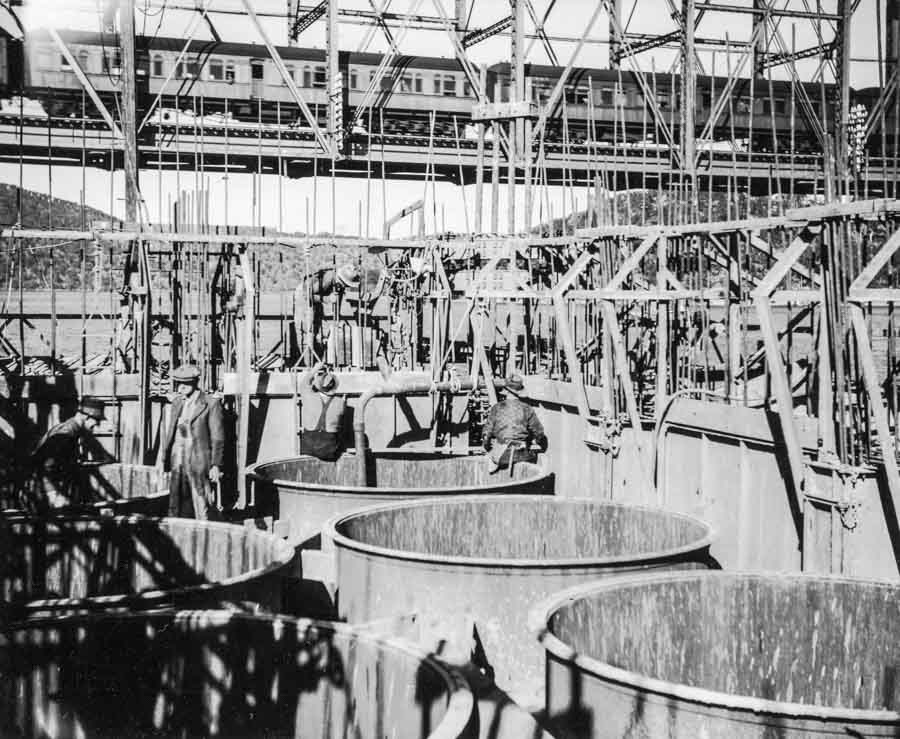
.
The piers, as was the case for the old bridge, were a great challenge. Three of the piers were founded on rock, but the other five sit on sand at depths between 54m and 56m. Those founded on sand needed special treatment. An article in the September 1946 issue of BHP Review described the process:
For the construction of the caissons, mild steel cutting edges and working chambers were fabricated, 16m x 9m x 4m high. They were launched at a slip adjacent to the workshops on the southern side of the river, whence they were towed to a dock adjacent to the southern abutment of the old bridge. Provision was made for eight dredging cylinders to be connected to the top of the working chamber. At the dock, reinforced concrete walls were built up from the steel cutting edge, and mass concrete was poured in between these walls and the dredging tubes to add weight and ensure stability of the floating structure. When the caisson had sunk to a pre-determined depth, it was then towed out to its final site on the river and securely anchored. Caissons 3 to 7 inclusive were sunk by the open dredging method and, as the structure moved downwards, additional concrete was added to the walls above water level to maintain freeboard, and concrete was poured between the walls and the dredging cylinders to give weight and overcome skin friction.
Caissons Nos. 2 and 8 were built each on two 5m-diameter cylinders founded under air pressure on rock at depths of 31m and 16m respectively. When, at the required depth, the caissons were sealed off at the cutting edges with a plug of concrete 3m thick. Then sand was poured into the dredging tubes up to one-half the height, approximately at the centre of the length of the caisson, where a plug of concrete 5m thick was poured on top of the sand. Concurrently with the sinking of the caissons, construction was commenced of the two tunnels to double railway line standard.
.

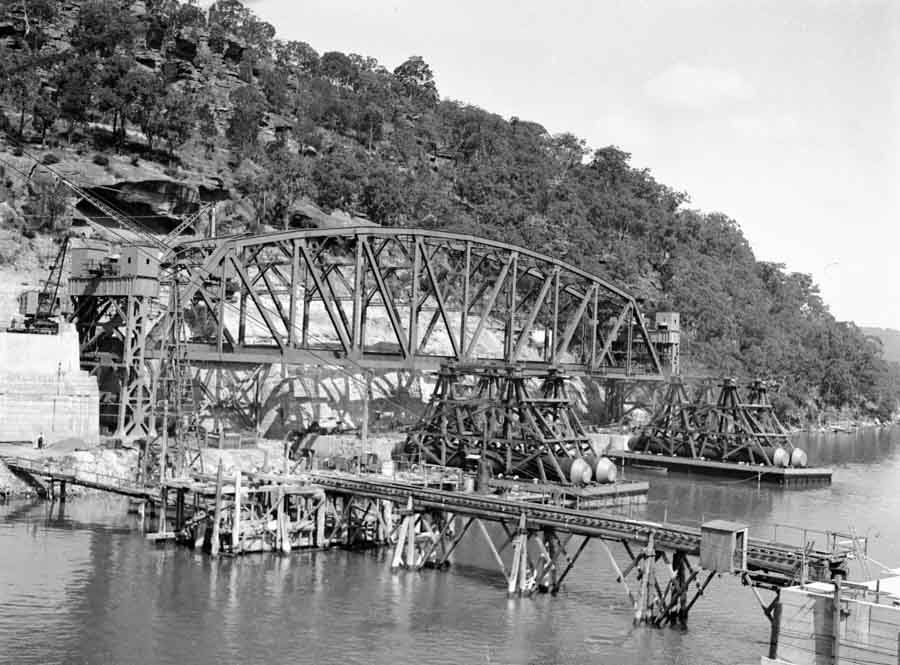
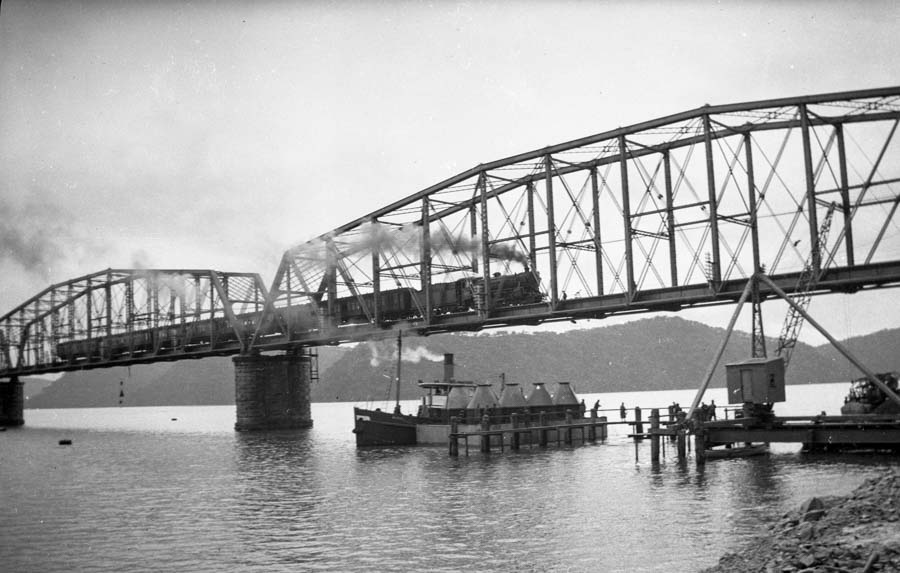
.
According to I. P. Berliner, writing in the August 1946 issue of the Australasian Railway and Locomotive Historical Society Bulletin:
A rectangular steel frame, forming the cutting edge of the caisson, was floated out from the shore and meticulously located in correction position by means of steel ropes and winches. The hollow concrete caisson proper was poured in forms on the cutting edge in stages, causing the whole to sink at a controlled rate, the forms sliding up by degrees as the worked proceeded. After descending through about 12m of water wand entering the silt bed, it became necessary to remove the muck through the dredging tubes, and this required the presence of workers within the cutting edge frame who were safeguarded from inundation by a sufficiently high air pressure in the air lock. There was a tendency for the caissons to tilt while sinking, and this was controlled by discharging water at high pressure round the cutting edge. The caissons were founded with great accuracy in spite of their great depth and the strength of the tides and currents.
The trusses were erected on a shelf excavated a little above water level out of the steep rocky shore of Long island immediately west of the southern end of the new bridge. The erecting crane was specially designed to travel along the side of the artificial cliff and cover the whole of the truss being erected as well as the unloading siding whence the fabricated members were received. When each truss was assembled sufficiently to allow it to be transferred to its piers, it was raised 8m by special lifting towers at each end so that it could be floated out at the elevation necessary to land on the piers. The heaviest trusses handled were the two 138m units weighing 1600 tonnes each.
.
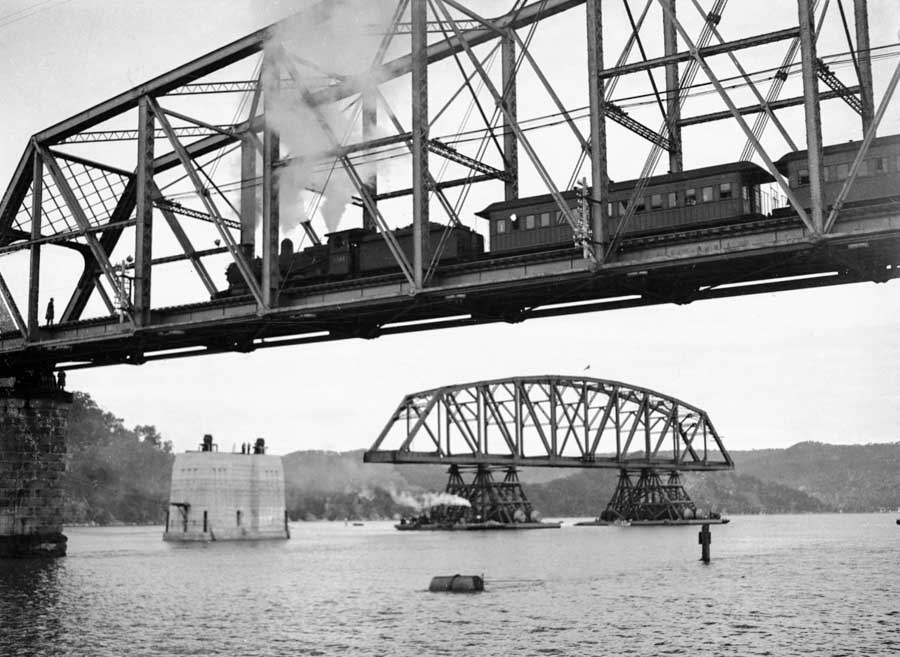

The trusses were conveyed from shore to their piers on pontoons having superstructures in the form of stools, the pontoons being floated into special docks under the raised truss. The rising tide, carefully chosen from meteorological data, raised the pontoons sufficiently to support the truss, fine adjustments in height being obtained by means of drums of water on the pontoon decks. The pontoons were controlled while in transit by means of anchor ropes which were paid out and taken in as required by steam winches on punts moored to the pontoons.
The complex operation was rehearsed using a scale model. The first truss was floated out on September 4, 1944, and the last was placed on its piers on May 14, 1946.
.
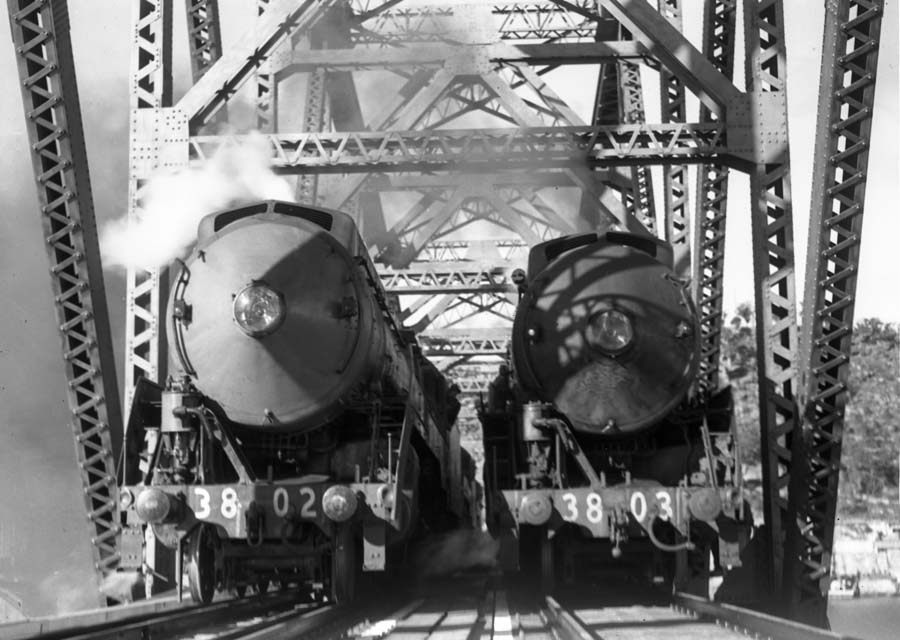
On Monday, June 24, 1946, the new bridge was tested on both tracks by six (Australian-built) C-38 class engines working in two sets, three coupled abreast, Engines 3801, 3802, 3804, 3803, 3807 and 3805 left Eveleigh in that order. The first three were uncoupled and passed over the old bridge singly, shunted into Mullet Creek construction siding and recoupled. They were then passed over the up line on the new bridge at about 9am, tender first, then stopped at the southern portal. The second three locos arrived and passed through the down refuge siding on to the new down line and stopped opposite the first three engines.
.
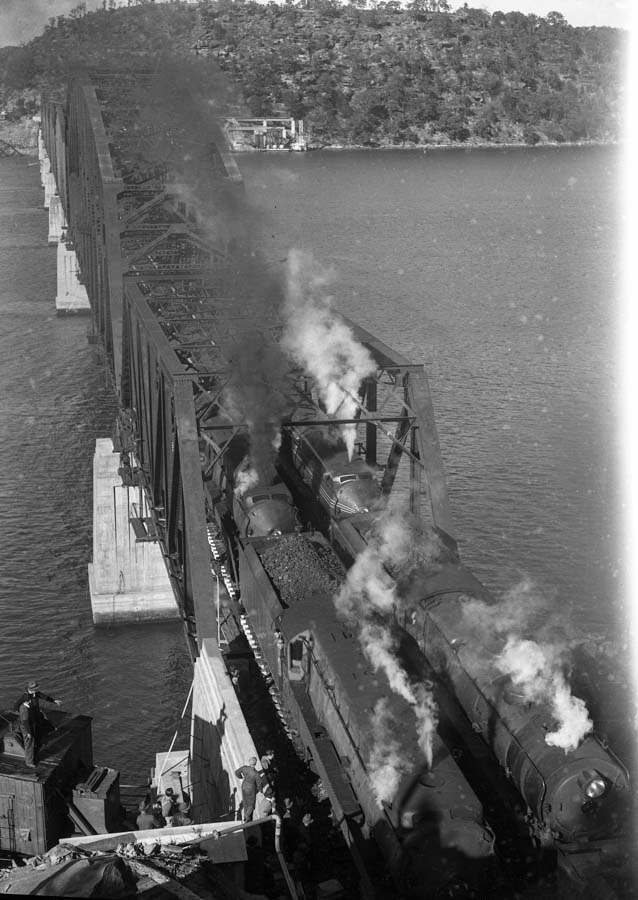
.
At about 9.15 all six moved slowly ahead and stopped for about a minute over each pier, and about 10am they all backed across again to check for possible settlement under a total test load of about 1250 tonnes.
After assembling between Long Island Tunnel and the bridge, the six locomotives were backed down the new causeway as far as the end of the up rails. According to R.B. McMillan, writing in the same bulletin:
At approximately 11am excited cock-crowing of whistles warned onlookers to be ready. Working all together in full gear, with rails sanded, the six engines accelerated up the 1 in 60 grade through the tunnel. With a deafening crash of exhausts, intensified by one of them slipping, they burst out of the tunnel onto the new bridge at about 35mph [56km/h] still steaming hard, the down line set a short nose in front which was soon caught up when the up set led slightly off the northern end, the bridge being traversed at just under 40mph [64km/h], leaving only a quarter of a mile to brake to a dead stop at the end of the tracks. In this test, which was a most spectacular performance, the engines were on the bridge for less than a minute. This completed the tests which were wholly satisfactory. The down line engines backed across the bridge and, after a pause for press and photographers, returned tender first to Eveleigh at a speed limit of 20mph [32km/h]. The up line engines ran forward to Woy Woy to cross to the old up line and were separated to work singly over the old bridge, then reunited and worked to Eveleigh tender first, all engines being back at the depot by 4pm.
The new bridge was officially opened on Monday, July 1, 1946. At the opening, NSW Premier William McKell said the occasion was very significant, but lacked the huge import of the opening of the first bridge, which provided critical rail connection between NSW and Queensland. In the 60 yeas between the two openings, the state’s population had more than doubled and about 300 trains a month were crossing the bridge by 1946. The Newcastle Morning Herald reported:
To the noise of thousands of cheering people, workshop sirens, whistles from trains and boats on the river, and the drone of a Catalina which flew low, the Premier cut the white ribbon with a pair of gold-plated scissors and allowed the first train to complete its journey across the bridge. While the official party was assembling, perway men were working at either end of the approach tunnels, switching over the rails from the old track to the new, so that all traffic could use the new bridge. The train bearing the official party arrived at Hawkesbury at 11.45am. It was flagged to the approach of the old bridge, where it waited until a northern passenger train crossed the old bridge.Hundreds of people crowded about the approach of the old bridge. They cheered loudly as the train passed onto the bridge and crossed at four miles per hour. Few of the official party knew they were on the last train to cross the old bridge until word was passed along the seven cars. On the northern side, the train stopped at Mullet Creek, where a 200-tonne C-38 class engine was waiting. This engine, which was decorated with an elaborate coat of arms and flags, was coupled to the back of the train and hauled it across the new bridge as the first train to cross the structure.
.
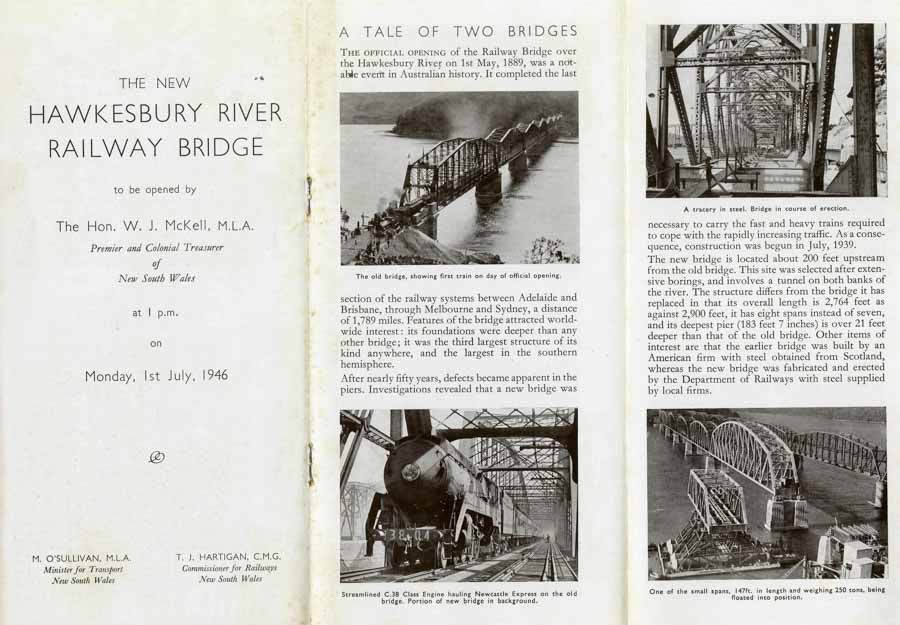
.
Speaking at the opening, the Minister for Transport, Mr O’Sullivan, said the old bridge had carried hundreds of thousands of Australian and allied troops on special trains without mishap. These operations caused great stress to the men who had been aware of the actual condition of the bridge, he said.
When the trusses of the old bridge were removed, the pins and I-beams were recycled on bridges and other railway structures around NSW.
.
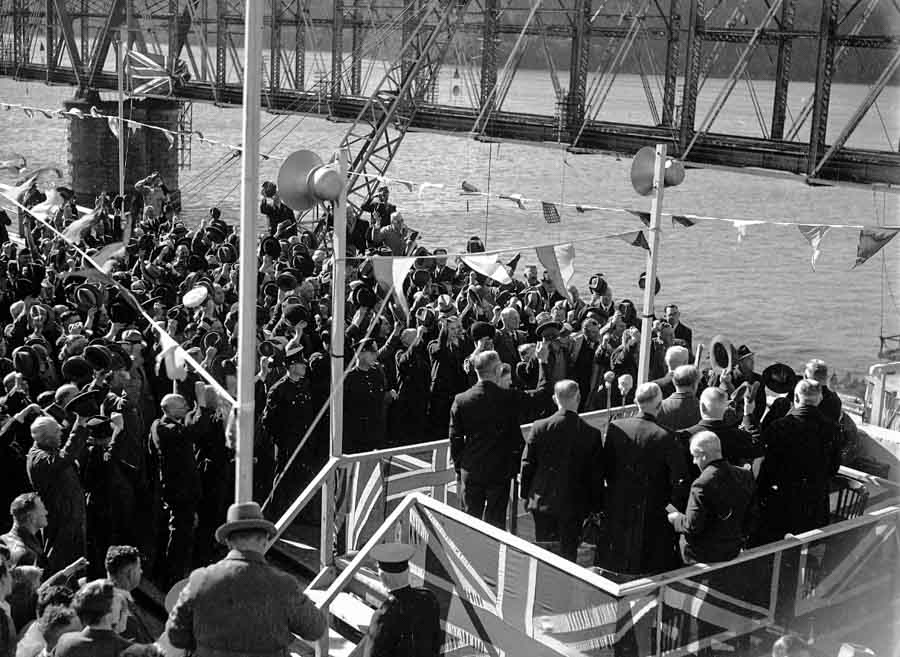

Footnote: In 2015 it was reported that the “new” bridge – then 60 years old – was suffering from cracking in some of its concrete, and from corrosion in some of its steel members. Sydney Trains imposed load limits on the bridge (one freight train at a time) and commissioned a report which recommended strengthening the upper section to bring the bridge into line with present-day standards. It is not known whether these works have been undertaken.

